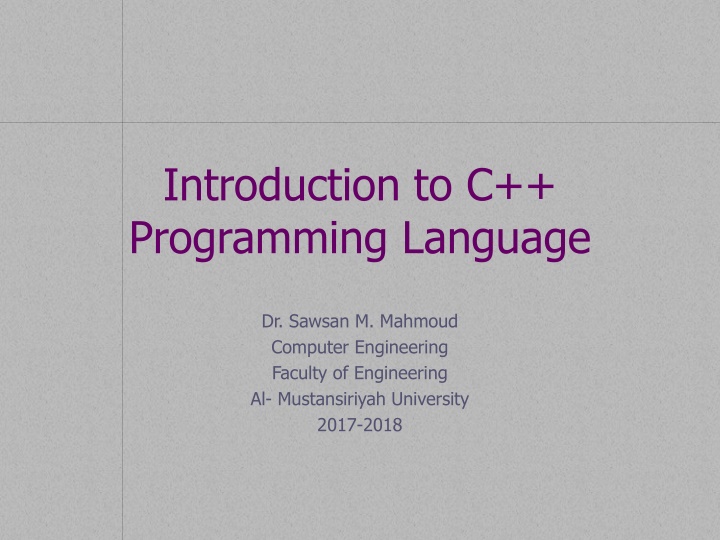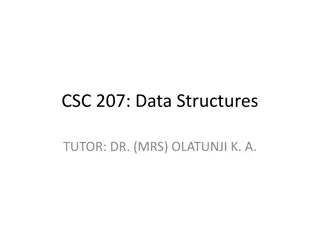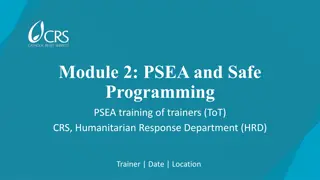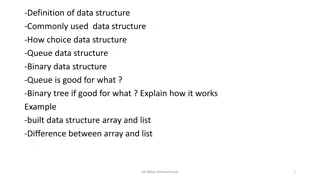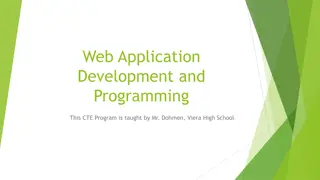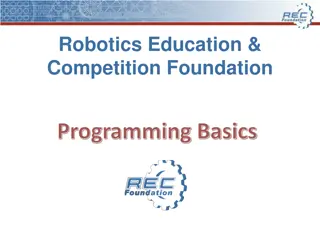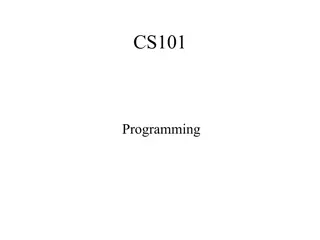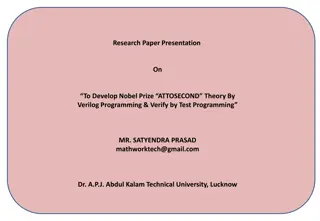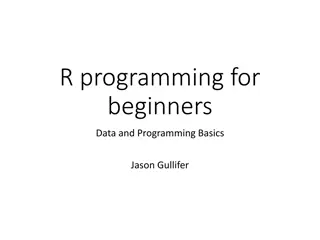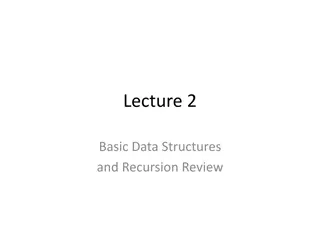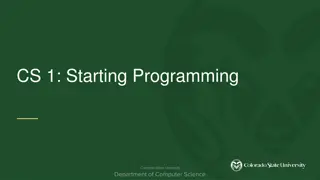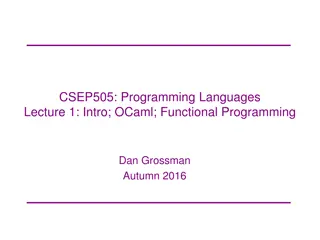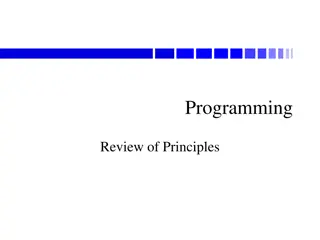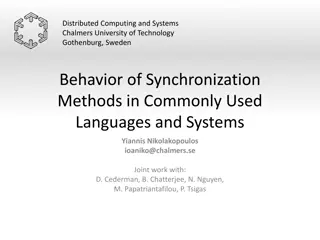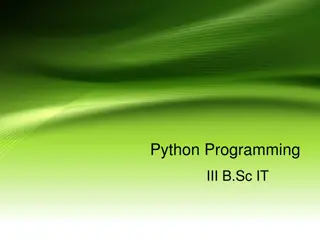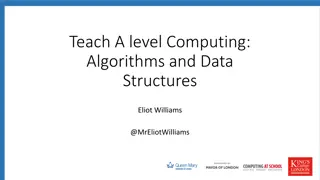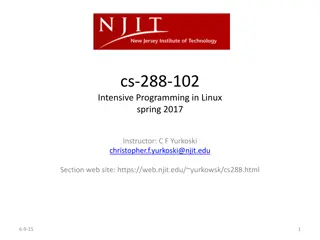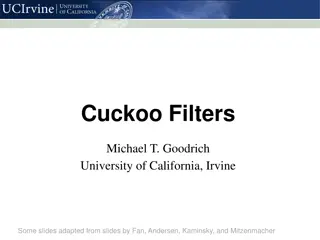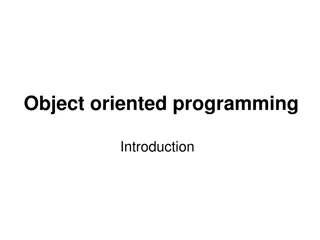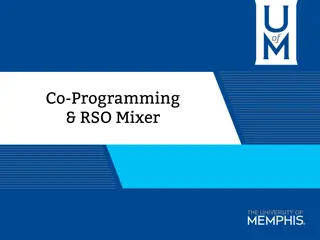Introduction to C++ Programming Data Structures
This course introduces basic data structures used in software development, covering concepts like declaration, variables, arrays, structures, and algorithms. Students will learn to analyze and apply data structures effectively, enabling them to make informed design decisions in programming.
Uploaded on Feb 19, 2025 | 0 Views
Download Presentation

Please find below an Image/Link to download the presentation.
The content on the website is provided AS IS for your information and personal use only. It may not be sold, licensed, or shared on other websites without obtaining consent from the author.If you encounter any issues during the download, it is possible that the publisher has removed the file from their server.
You are allowed to download the files provided on this website for personal or commercial use, subject to the condition that they are used lawfully. All files are the property of their respective owners.
The content on the website is provided AS IS for your information and personal use only. It may not be sold, licensed, or shared on other websites without obtaining consent from the author.
E N D
Presentation Transcript
Introduction to C++ Programming Language Dr. Sawsan M. Mahmoud Computer Engineering Faculty of Engineering Al- Mustansiriyah University 2017-2018
Contact Name: Email: Room: Software Engineering Lecture Time: Tuesday 11:30 - 02:30 Thursday 08:30 - 11:30 Notes: Other office hours are available by an appointment. The contents of this syllabus is not to be changed during the current semester. Sawsan M. Mandalawi sawsan.mandalawi@yahoo.com Room 6 in the Department of Computer & Wednesday, February 19, 2025 C++ Programming Language 2
What is this Module all about? This course introduces the basic data structures used in computer software Understand the data structures Analyze the algorithms that use them Know when to apply them Also, practice design and analysis of data structures and practice using these data structures by writing programs. On successful completion of this course, you will understand: What the tools are for storing and processing common data types Which tools are appropriate So that you will be able to make good design choices as a developer, project manager, or system customer Wednesday, February 19, 2025 C++ Programming Language 3
Module Content Introduction C++ programming language Declaration, Comments, Numbers, Variables, I/O data (cout, cin). Expressions and Assignments, Increment and Decrement Operator, Combined Operator. Selection and Switch, If statement Nested If, If else, Switch Repetition statement, While, Do While For Nested For statement. One dimensional array I. One dimensional array II. Two dimensional array I. Two dimensional array II. Structure I Structure II C++ Programming Language 4 Wednesday, February 19, 2025
Sources of Information Book Richard L. Halterman (2017), Fundamentals of Programming C++. Suggested references Clifford A. Shaffer, Virginia Tech (2011), Data Structures and Algorithm Analysis. James F. Korsh,Leonard J.Garrett (2008), Data Structures, Algorithms, and Program style using(c), Textbook. Michael T. Goodrich, Roberto Tamassia. David M. Mount (2007), Data Structures and Algorithms in C++ . C++ Programming Language 5 Wednesday, February 19, 2025
Assessment C++ Programming Language Assessment of Learning: The student will be evaluated based on homework, exams, and class participation. Examination Information: The exams will cover material that has been discussed in class or covered in the book. Assignments: Homework must be submitted at the beginning of class on the date which it is due. Late homework will be accepted only when special circumstances are approved by the instructor. Terms examination: 40% Term Exams Assignments Final Exam: 60% Wednesday, February 19, 2025 C++ Programming Language 6
Lecture one Introduction C++ Programming Language Wednesday, February 19, 2025 C++ Programming Language 7
Computer and Development Tools A computer program is a sequence of instructions that dictate the flow of electrical impulses within a computer system. These impulses computer s memory and interact with the display screen, keyboard, mouse, and perhaps even other computers across a network in such a way as to permit humans to perform useful tasks, solve high-level problems, and play games. affect the Wednesday, February 19, 2025 C++ Programming Language 8
Computer and Development Tools Software must be stored in the computer s memory. These patterns of electronic symbols are best represented as a sequence of zeroes and ones, digits from the binary (base 2) number system. An example of a binary program 10001011011000010001000001001110 Software can be represented by printed words and symbols that are easier for humans to manage than binary sequences. Tools exist that automatically convert a higher-level description of what is to be done into the required lower-level code. sequence is: Wednesday, February 19, 2025 C++ Programming Language 9
Computer and Development Tools Higher-level programming languages like C++ allow programmers to express solutions to programming problems in terms that are much closer to a natural language like English. Some examples of the more popular of the hundreds of higher-level programming languages that have been devised over the past 60 years include FORTRAN, COBOL, Lisp, Haskell, C, Perl, Python, Java, and C#. A C++ compiler is used to translate the C++ code into machine code. The higher-level language code is called source code. The compiled machine language code is called the target code. The compiler translates the source code into the target machine language. Wednesday, February 19, 2025 C++ Programming Language 10
Computer and Development Tools An editor allows the user to enter the program source code and save it to files. Most programming editors increase programmer productivity by using colors to highlight language features. The syntax of a language refers to the way pieces of the language are arranged to make well-formed sentences. programmers must follow strict syntax rules to create well-formed computer programs. Only well-formed programs are acceptable and can be compiled and executed. Some syntax-aware editors can use colors or other special annotations to alert programmers of syntax errors before the program is compiled. Wednesday, February 19, 2025 C++ Programming Language 11
Computer and Development Tools Wednesday, February 19, 2025 C++ Programming Language 12
The Task of Programming Machine language: language that computers can understand; it consists of 1s and 0s Interpreter: program that translates programming language instructions one line at a time Compiler: translates entire program at one time Run a program by issuing a command to execute the program statements Test a program by using sample data to determine whether the program results are correct Wednesday, February 19, 2025 C++ Programming Language 13
What is C? Programming languages provide the appropriate formulas to define and use primitive data types. C is a rather old programming language (1972, Richie, Bell Labs) Originally designed as a systems software platform (OS and the like) Procedural, block oriented language (no object-oriented programming) Dennis Ritchie Inventor of the C Programming Language Wednesday, February 19, 2025 C++ Programming Language 14
Why learn C++? Small, extensible language. Progenitor of many languages. It is everywhere! (portable) Many applications and much support due to its age and general use Many tools written to support C++ development. Close to the hardware, programmer manages memory Easy to interface with system devices/assembly routines Common embedded systems language Wednesday, February 19, 2025 Can be fast, efficient (most cited reason) C++ Programming Language 15
Why Learn C++? The following program is written in the C programming language: #include <iostream.h> main() { /* My first program */ cout<< Hello World! \n ; } Wednesday, February 19, 2025 Data Structure 16
C++ Program C++ is case sensitive. All commands in C must be lowercase. C++ has a free-form line structure. End of each statement must be marked with a semicolon. Multiple statements can be on the same line. White space is ignored. Statements can continue over many lines. Wednesday, February 19, 2025 Data Structure 17
C++ Program The C program starting point is identified by the word main(). This informs the computer as to where the program actually starts. The parentheses that follow the keyword main indicate that there are no arguments supplied to this program (this will be examined later on). The two braces, { and }, signify the begin and end segments of the program. In general, braces are used throughout C to enclose a block of statements to be treated as a unit. COMMON ERROR: unbalanced number of open and close curly brackets! Wednesday, February 19, 2025 Data Structure 18
C++ Program The purpose of the statement #include <iostream.h> is to allow the use of the cout statement to provide program output. For each function built into the language, an associated header file must be included. cout is actually a function (procedure) in C++ that is used for printing variables and text. This has to do with the \ and % characters. These characters are modifiers, and for the present the \ followed by the n character represents a newline character. Wednesday, February 19, 2025 Data Structure 19
C++ Program Thus the program prints Hello World! And the cursor is set to the beginning of the next line. Comments can be inserted into C++ programs by bracketing text with the /* and */ delimiters. Comments are useful for a variety of reasons. Primarily they serve as internal documentation for program structure and functionality. Wednesday, February 19, 2025 Data Structure 20
Why Use Comments? Documentation of variables and functions and their usage Explaining difficult sections of code Describes the program, modification changes, revisions ** Best programmers comment as they write the code, not after the fact. author, date, Wednesday, February 19, 2025 Data Structure 21
Header Files Header files contain definitions of functions and variables which can be incorporated into any C++ program by using the pre-processor #include statement. Standard header files are provided with each compiler, and cover a range of areas: string handling, mathematics, data conversion, printing and reading of variables, etc. For example, to use the function cout in a program, the line #include <iostream.h> should be at the beginning of the source file, because the declaration for cout is found in the file iostream.h. Wednesday, February 19, 2025 Data Structure 22
Header Files All header files have the extension .h and generally reside in the /usr/include subdirectory. #include <string.h> #include <math.h> #include "mylib.h The use of angle brackets <> informs the compiler to search the compiler s include directories for the specified file. The use of the double quotes "" around the filename informs the compiler to start the search in the current directory for the specified file. Wednesday, February 19, 2025 Data Structure 23
Header Files All header files have the extension .h and generally reside in the /usr/include subdirectory. #include <string.h> #include <math.h> #include "mylib.h The use of angle brackets <> informs the compiler to search the compiler s include directories for the specified file. The use of the double quotes "" around the filename informs the compiler to start the search in the current directory for the specified file. Wednesday, February 19, 2025 Data Structure 24
